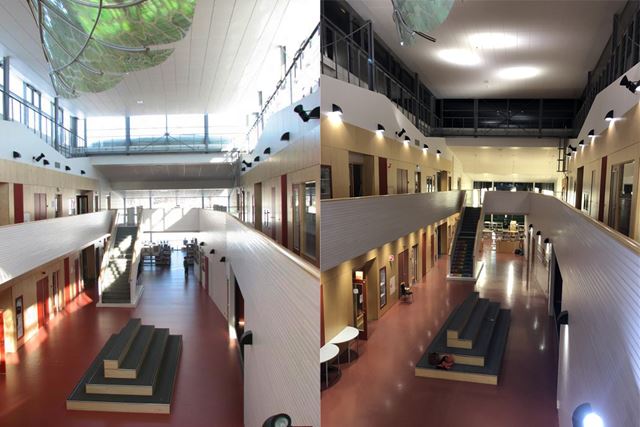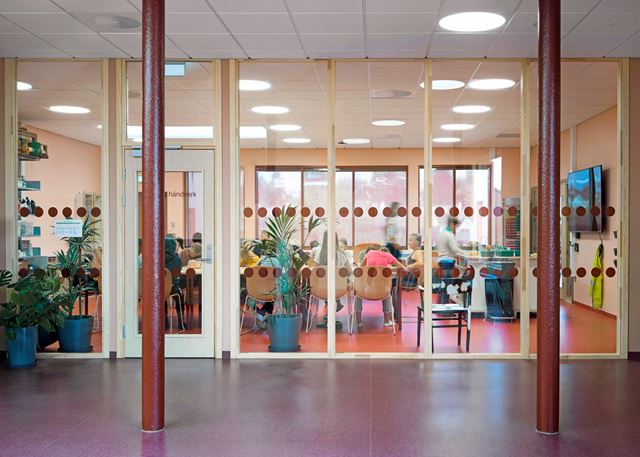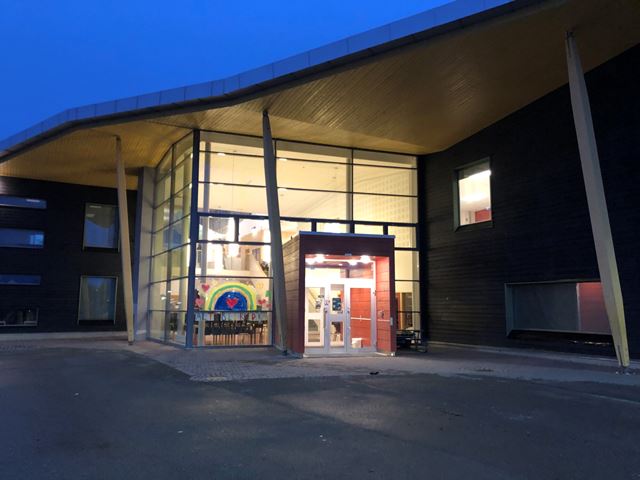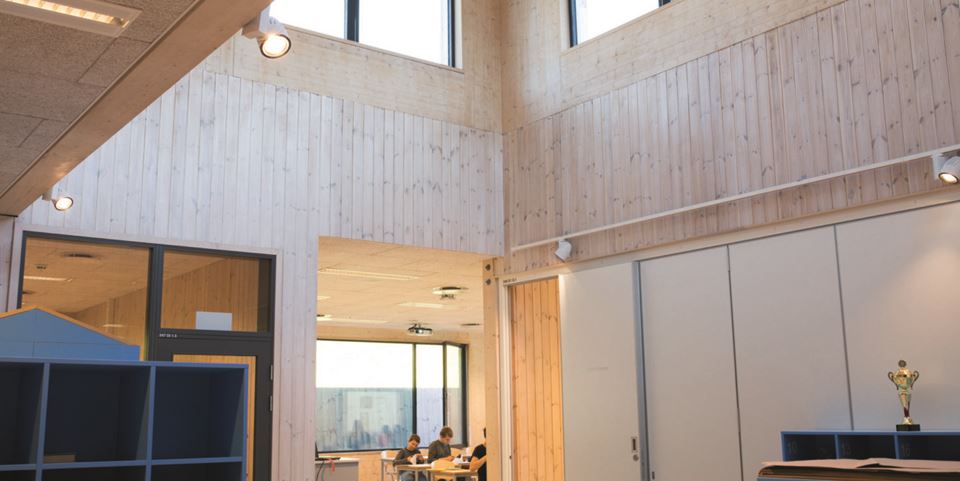We now have comprehensive scientific evidence of the effects that light has on people. For example, light is directly linked to our diurnal rhythm.
This rhythm adapts our bodies to a 24-hour cycle of light and dark. Light regulates such things as our sleeping patterns, body temperature and levels of stress hormones In other words, daylight is crucial to ensuring that our diurnal rhythm works as it should.
SINTEF has recently completed a project to compile all existing research findings in this field. The result is a set of brand new guidelines on how lighting in school buildings should be designed.
“Since light impacts on pupils in different areas, it’s important to conduct more research into exactly how light can be utilised in Norwegian schools”, says SINTEF researcher Claudia Moscoso. “Well-lit learning spaces can support education and promote good physical and psychological development among school pupils”, she says.
Light conditions are very important to children at school who spend a lot of their time indoors. It impacts on their alertness, cognitive skills and levels of the stress hormone cortisol. Moreover, conditions in Scandinavia are such that their exposure to blue light in the mornings is reduced during the long winter months. This light is essential to activating our biological clocks.
Large windows lead to better exam results
For example, a UK study carried out in 2015 (the HEAD Project), which collected data from 3,766 schoolchildren in the UK, found that well-designed primary schools served to boost pupils’ academic performance in reading, writing and maths. A finding of particular interest was that 16 percent of the variation in learning development over a one-year period could be explained by the physical design of the classroom.
These results clearly demonstrated that light was the factor that exerted the greatest effect (21 percent), while air quality (16 percent) and temperature (12 percent) also had a major influence. These three factors were thus responsible for almost half of the effect on learning development.
Another scientific study [1] found that classrooms with large windows were associated with between 15 and 23 percent of the improvement in pupils’ exam results. It also showed that adequate and stable daylight conditions throughout the year boosted academic skills by between 20 and 26 percent, compared with classrooms with low levels of daylight.

The entrance area of Fagereng school in Tromsø photographed in daylight during the summer (left) and under artificial lighting in winter (right). Architects: Fråne Hederus Malmström arkitekter and Arkitektlaget. Photo: HMXW arkitekter and Solvår Wågø/SINTEF
Does adequate lighting promote less absenteeism?
A third study found that classrooms with adequate access to daylight and sunlight were associated with less pupil absenteeism and improved academic skills [2]. On the other hand, classrooms with inadequate lighting design can restrict pupils’ ability to learn. This is because low levels of lighting can impact on a child’s visual system and thus restrict access to visual information and suppress learning ability[3].
In fact, the difference between classrooms with windows (providing adequate daylight conditions) and those without has been found to influence cortisol levels in children, which in turn are associated with pupils’ psychological health and levels of concentration in the classroom [4]. Another major research project , which used data taken from 2,837 schoolchildren aged from 8 to 12, found that pupils working in classrooms with large windows exhibited better academic skills compared with those in classrooms with less window area[5].
Facts about the report:
This report is one of a series of publications, reports and studies produced by the project Morgendagens skoler (Schools of the Future). The project is scheduled for the period 2020 to 2023 and is a public sector innovation project funded by the Research Council of Norway. Schools for the Future is a collaborative project between SINTEF Community, the Department of Education and Lifelong Learning at NTNU, and the Norwegian municipalities of Tromsø, Bergen, Trondheim and Nordre Follo. Tromsø municipality is acting as project owner.
In the case of artificial light, research studies have found that variable levels of lighting (i.e. Illumination that varies both in strength and colour temperature) serve to boost academic skills in reading speed and comprehension. For example, skills in reading aloud were increased for 38 percent of pupils working under variable lighting conditions, compared with only 18 percent for those under normal white light[6].
It has also been found that blue-enriched white light reduces restlessness and aggressive behaviour among schoolchildren compared with standard white light[7].

Art and handicrafts spaces at Hebekk School in Nordre Follo. Architect and photo: Planforum Arkitekter
Many variables
Even though minimum lighting requirements have been stipulated for Norwegian schools, these do not in fact guarantee adequate lighting quality in any given school space. For example, the requirements linked to daylight, such as daylight factor (DF), describe an average value for overcast weather.
“If a classroom only succeeds in achieving the minimum requirement of 2 percent DF as set out in the Norwegian statutory building regulations (TEK17), or the Lyskultur recommendation of 5 percent DF, the same classroom may still encounter issues with glare or overheating under clear skies”, explains Moscoso.
Moreover, the requirements for artificial light offer inadequate information about the colour temperature of the light source. In fact, research has shown that the colour temperature of a light source impacts on both the behaviour and psychological and mental states of pupils.
So, in order to carry out a comprehensive assessment of lighting conditions in schools, we have to analyse other parameters. For example, classrooms should be monitored to identify issues linked to glare. We should be noting the colours of surfaces and assessing whether the pupils’ visual environment is good enough to provide them with mental and visual ‘relief’.

Low levels of lighting in the autumn and winter, such as here at Fagereng School in Tromsø, reduce exposure to natural blue light and make the use of artificial light essential. Architects: Arkitektlaget and HMXW arkitekter. Photo: Solvår Wågø/SINTEF
Linked to architecture
Classrooms and group rooms are among the most important learning spaces in any school.
“This makes it very important to evaluate the floor plans and physical design of such spaces”, explains Moscoso. “For example, we must look at daylight openings (windows and skylights, if any) and their design, the types of glass, installation angles, as well as the accessibility of sun-screening or daylighting systems”, she says.
The aim of daylighting systems is to make better use of daylight, for example by allowing it to penetrate deeper into a space, or by distributing the light more evenly. Even if these factors have already been considered during the design phase, it is also common to retrofit them in existing buildings.
“It’s also beneficial to focus on the arrangement of furniture in a space, the colour and reflectivity of surfaces, and the location of whiteboards and suchlike. This can provide us with important input during our analyses of light distribution, contrasts and factors that can cause glare”, says Moscoso.
Improving light conditions
The researchers have now attempted to identify a suitable method that incorporates the most important factors that should be assessed in the search for a well-lit classroom. Their literature review offers an evaluation of the most important aspects of lighting in school spaces and the methods that can be used to record light conditions in our schools.
“This information can be used in the future either to evaluate and improve existing light conditions in schools, or serve as a set of recommendations during the planning of new schools designed to support learning and well-being”, says Moscoso.
References:
Claudia Moscoso: Lys og evalueringsmetoder for belysning i skoler. Litteraturstudium (Light and assessment methods for lighting in schools – a literature study. SINTEF Technical Reports (2022).
[1] Heschong, L., Wright, R. & Okura, S. (2002). Daylighting Impacts on Human Performance in School. Journal of the Illuminating Engineering Society, 31 (2), 101-114.
[2] Demir, A. (2013). Impact of daylight on student and teacher performance. Journal of Educational and Instructional Studies in the World, 3 (1), 1-7.
[3] Dass, M., Ibrahim, N. & Lukman, N. (2014). Evaluation of daylighting at public school classrooms in Ipoh, Perak. Alam Cipta, 71(1), 27-34.
[4] Küller, R. & Lindsten, C. (1992). Health and Behavior of Children in Classrooms with and without windows. Journal of Environmental Psychology, 12, 305-317.
[5] Maesano, C. & Annesi-Maesano, I. (2016). Impact of Lighting on School Performance in European Classrooms. Paper presented at CLIMA 2016, 12th REHVA World Congress, Aalborg, Denmark.
[6] Mott, M., Robinson, D., Walden, A., Burnette, J. & Rutherford, A. (2012). Illuminating the Effects of Dynamic Lighting on Student Learning. SAGE Open, 1-9.
[7] Wessolowski, N., Koenig, H., Schulte-Markwort, M. & Barkmann, C. (2014). The effect of variable light on the fidgetiness and social behavior of pupils in school. Journal of Environmental Psychology, 39, 101-108.


